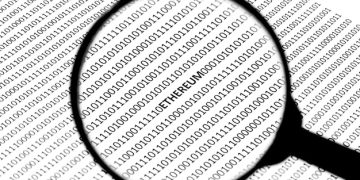Smart Contract Auditing: A Step-by-Step Guide for US Developers

Smart contract auditing is a meticulous review process essential for US developers to identify vulnerabilities and ensure the security and reliability of their blockchain-based applications before deployment.
Are you a US developer venturing into the world of smart contracts? Ensuring the security and reliability of your code is paramount. This guide provides a step-by-step approach to smart contract auditing: a step-by-step guide for US developers, helping you navigate the complexities and safeguard your projects.
Understanding the Importance of Smart Contract Auditing
Smart contract auditing is not merely a best practice; it’s a necessity. As blockchain technology continues to evolve, so do the threats targeting smart contracts. For US developers, understanding the importance of rigorous auditing can prevent devastating financial losses and reputational damage.
Why Audit Your Smart Contracts?
Auditing helps to identify potential vulnerabilities that could be exploited by malicious actors. It’s like having a second pair of eyes ensuring every line of code is secure and functions as intended.
- Prevent Exploits: Audits can uncover bugs and security flaws before they lead to exploits.
- Enhance Trust: A clean audit report builds confidence in your smart contract among users and investors.
- Compliance: Some jurisdictions may require audits for smart contracts handling significant financial transactions.

For US developers, adhering to compliance standards is critical. Smart contract audits provide a way to ensure adherence to these standards, minimizing potential legal and financial complications.
Key Steps in Performing a Smart Contract Audit
A comprehensive smart contract audit involves several crucial steps that ensure the code is thoroughly examined. These steps cover everything from initial planning to the final report.
1. Planning and Preparation
Before diving into the code, clearly define the scope and objectives of the audit. This includes identifying what needs to be audited, understanding the contract’s functions, and gathering all relevant documentation.
2. Code Review and Analysis
This involves a detailed examination of the source code to identify any potential vulnerabilities. Auditors look for common issues such as:
- Reentrancy Attacks: When a contract can recursively call itself before the initial execution is complete.
- Integer Overflow/Underflow: When numerical calculations result in values that exceed the maximum or fall below the minimum representable value.
- Timestamp Dependence: Relying on timestamps for critical logic, which can be manipulated by miners.
Automated tools and manual code review techniques are used to ensure comprehensive coverage. For instance, tools like Slither and Mythril can automatically detect common vulnerabilities, while manual review helps in understanding complex logic and identifying subtle flaws.
By meticulously examining the code, auditors can catch vulnerabilities that automated tools might miss, improving the overall security and integrity of the smart contract.
Selecting the Right Auditing Firm
Choosing the right auditing firm is a critical decision that can significantly impact the quality of the audit. US developers need to consider several factors to ensure they are getting the best possible service.
Factors to Consider
Experience, expertise, and reputation are paramount. Look for firms with a proven track record in smart contract auditing and a deep understanding of blockchain technology.
Assessing the Audit Team
Look into the backgrounds and qualifications of the auditors who will be working on your project. Certifications like Certified Information Systems Security Professional (CISSP) and Certified Ethical Hacker (CEH) can indicate a high level of expertise.
Choosing an auditing firm that aligns with your project’s specific needs and objectives is essential. Effective communication and a transparent auditing process are also key indicators of a reliable firm.

Understanding Audit Reports and Remediation
Once the audit is complete, the auditing firm will provide a detailed report outlining all findings. Understanding this report and taking appropriate remediation steps is crucial. For US developers, this is an opportunity to strengthen the security of their smart contracts based on expert feedback.
Key Components of an Audit Report
An audit report typically includes an executive summary, a detailed description of the audit methodology, a list of identified vulnerabilities with severity ratings, and recommendations for remediation.
The Remediation Process
Remediation involves fixing the identified vulnerabilities and retesting the smart contract. This may require significant code changes, so it’s important to prioritize vulnerabilities based on their severity.
- Severity Ratings: Understand the impact of each vulnerability.
- Documentation: Maintain detailed records of all changes made during the remediation process.
- Testing: Rigorously test the smart contract after applying fixes.
The remediation process isn’t just about fixing bugs; it’s also an opportunity to learn and improve coding practices. This iterative process enhances the smart contract’s security and reliability, leading to a more robust and trustworthy application.
Leveraging Automated Tools for Smart Contract Security
Automated tools play a vital role in smart contract security. For US developers, these tools can significantly enhance the efficiency and thoroughness of the auditing process.
Popular Tools for Automated Analysis
Tools like Slither, Mythril, and Oyente can automatically detect common vulnerabilities in smart contracts. These tools use static analysis and symbolic execution techniques to identify potential security flaws.
Best Practices for Using Automated Tools
While automated tools are powerful, they are not a substitute for manual review. Here are some best practices:
- Regular Updates: Keep your tools updated to ensure they can detect the latest vulnerabilities.
- Configuration: Customize the tool settings to match your project’s specific requirements.
- Combine Techniques: Use automated tools in conjunction with manual code review.
Automated tools provide an additional layer of security by quickly scanning for known vulnerabilities, allowing auditors to focus on more complex and project-specific issues. Integrating these tools into the development workflow is a proactive approach to mitigating risks and enhancing the overall security posture of smart contracts.
Staying Ahead: Continuous Security Practices
Smart contract security is an ongoing process, not a one-time event. For US developers, adopting continuous security practices is essential to stay ahead of evolving threats.
Implementing Security Best Practices
This includes adhering to secure coding standards, conducting regular security audits, and keeping abreast of the latest security threats. Continuous monitoring can help detect and respond to potential attacks in real-time.
Importance of Ongoing Monitoring
Tools like runtime monitoring systems can provide valuable insights into the behavior of smart contracts in production. These systems can detect anomalies and alert developers to potential security incidents.
By integrating security into every stage of the smart contract lifecycle, US developers can build more secure and reliable applications. This proactive approach helps protect against potential exploits and builds trust among users and stakeholders.
| Key Aspect | Brief Description |
|---|---|
| 🛡️ Audit Importance | Essential for identifying vulnerabilities and preventing exploits. |
| 🔍 Code Review | Involves detailed examination to detect vulnerabilities. |
| 🛠️ Remediation | Fix vulnerabilities and retest; crucial for security. |
| 🚀 Automated Tools | Enhance audit efficiency. Use with manual review. |
FAQ Section
▼
It is essential for US developers because it helps identify and prevent vulnerabilities that could lead to financial losses or reputational damage, ensuring compliance with regulatory standards.
▼
Key steps include planning, code review, vulnerability analysis, testing, and report generation. Each step ensures thorough examination and identifies potential security flaws.
▼
Consider their experience, expertise, reputation, and the qualifications of their audit team. Effective communication and a transparent auditing process are also crucial.
▼
An audit report should include an executive summary, methodology, identified vulnerabilities with severity ratings, and recommendations for remediation to improve security.
▼
Automated tools quickly scan for known vulnerabilities, improving audit efficiency. They should be used with manual code review for comprehensive security assurance in smart contracts.
Conclusion
For US developers, smart contract auditing: a step-by-step guide for US developers is indispensable for creating secure and reliable blockchain applications. By following these steps and adopting continuous security practices, you can enhance the integrity of your smart contracts, build trust among users, and stay ahead of evolving threats. The future of blockchain depends on secure, audited code.





